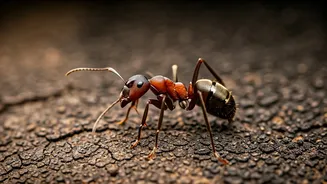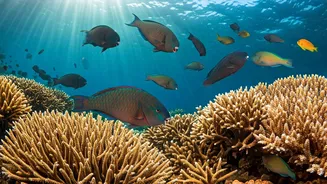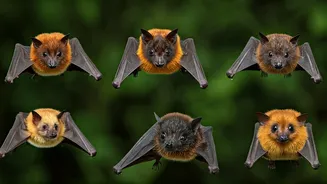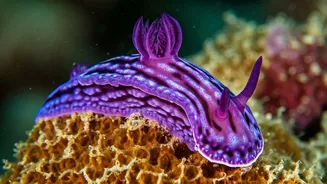Survival's Champions Unveiled
Our planet harbors a diverse range of organisms, many of which are extraordinarily well-equipped to handle harsh environments. Among the most remarkable
are creatures capable of surviving intense heat, including fire and potentially even nuclear events. These animals have evolved unique physiological and behavioral adaptations that allow them to endure conditions that would be fatal to most other species. This article will look at seven such examples, showcasing their unique survival strategies. You might even be surprised to learn that some of these resilient beings are common in our surroundings. Their existence highlights the sheer tenacity of life and its ability to adapt and thrive in the face of adversity. Let's delve into the fascinating world of these extreme survivors and uncover their secrets to enduring such challenging circumstances.
The Resilient Ants
Ants, often found in our homes and gardens, are among the toughest creatures on Earth. These industrious insects have an incredible ability to withstand fire, though not directly in the flames. When faced with a fire, ant colonies take action to safeguard their young. The colony's response usually includes carrying their larvae and pupae to safety. They also have an impressive social structure and can quickly react to environmental changes. This ability to evacuate the colony to safer areas is a key survival strategy. Their small size and adaptability to a wide range of habitats make them incredibly successful. Ants' resilience extends beyond fire resistance, and they can also thrive in various challenging environments. They show that even the smallest creatures can display remarkable strength and adaptability in the face of danger. In fact, if the fire passes, the ants will return back to their colonies to check what they can salvage.
Braconid Wasps' Defense
Braconid wasps, known for their parasitic lifestyle, also exhibit a surprising degree of resilience to fire. While not directly immune to flames, these wasps have survival strategies. They are commonly found in environments that may experience wildfires or intense heat. One key is their life cycle, which often sees them developing inside a host. In the event of a fire, the wasp larvae or pupae may be protected within a host organism. Their small size and ability to seek shelter in protected locations are crucial for survival. These wasps contribute to ecosystem health by controlling other insect populations. This makes them a vital part of the natural world, showing how some species adapt to face threats. Moreover, their ability to survive in fire-prone environments is another indication of their flexibility and adaptability. Their existence is a testament to the remarkable versatility of life and the ability to adapt to extreme conditions.
Wood Frog's Remarkable Toughness
Wood frogs have earned a place on the list of fire-resistant animals, particularly due to their remarkable ability to withstand freezing temperatures. During winter, these frogs can freeze solid, with their bodily functions ceasing. They do this because they are able to create an antifreeze in their bodies by increasing the amount of glucose that their liver produces. When the weather gets warmer, the frogs can thaw and resume normal life. This tolerance for extreme cold also provides them with some resistance to heat. They can endure short periods of intense heat exposure by sheltering in moist environments. Their ability to deal with dramatic temperature changes adds to their overall resilience. Their survival strategy is a prime example of their tenacity and adaptation. They can adapt to diverse and often harsh environmental circumstances because of the way their bodies handle these temperature shifts.
The Pyrophilic Beetles
Pyrophilic beetles, as their name suggests, are fire-loving creatures, with a fondness for habitats affected by fire. These insects are attracted to burned areas, where they can find food, shelter, and reduced competition. After a fire, the landscape is cleared of many other species. Pyrophilic beetles' ability to thrive in these areas lets them access resources more easily. Their larvae can develop within burnt wood, and some species even feed on the charred remains of plants and animals. This unusual behavior makes them essential contributors to the ecological process. They demonstrate a remarkable ability to adapt to conditions that are hostile to most species. Their presence also shows how fire can support biodiversity. These beetles exemplify the ability of life to not only endure but also to thrive in unexpected and challenging environments. Their existence shows that every disaster is also an opportunity.
Tardigrades' Endurance
Tardigrades, often called water bears or moss piglets, are among the most resilient animals. These tiny invertebrates are known for their extraordinary ability to survive extreme conditions. They can withstand radiation, dehydration, starvation, and even the vacuum of space. While their direct tolerance for fire is not as well-documented as other animals, their overall robustness suggests they can endure extreme heat exposure. They enter a dormant state known as cryptobiosis, in which they can survive for years without water, food, or oxygen. This state enables them to withstand environmental stressors that would kill most other organisms. Tardigrades have proven to be an astonishing model of resilience. These creatures are a powerful illustration of the extremes to which life can adapt. Their survival shows the potential for life to survive even the most catastrophic environmental events.
Scorpions' Protective Armor
Scorpions are tough creatures that have adapted to harsh environments. Their resilience, though, is not as directly linked to their ability to endure fire as that of others on this list. However, their exoskeletons can shield them from a certain degree of heat. Scorpions are commonly found in arid and semi-arid environments where temperatures fluctuate greatly. They have developed several strategies to cope with extreme heat. These involve seeking shelter under rocks, in burrows, or during the hottest part of the day. Their venom, though dangerous, is a crucial part of their survival and is used for hunting and self-defense. They can thrive in difficult conditions, making them a testament to their adaptability. Scorpions offer a lesson in survival and adaptation. Their ability to live in some of the most challenging environments is proof of their amazing resilience and ability to endure the planet's toughest conditions.











